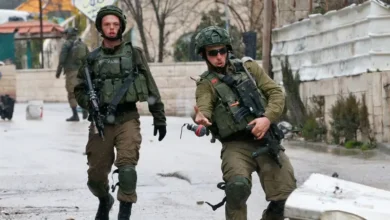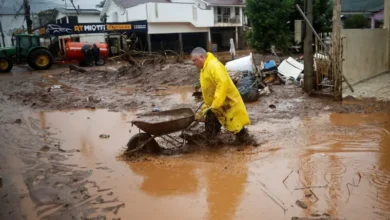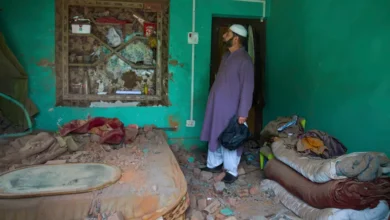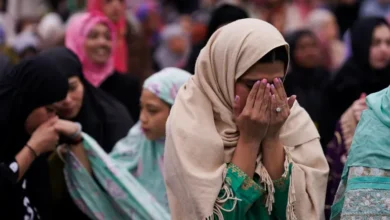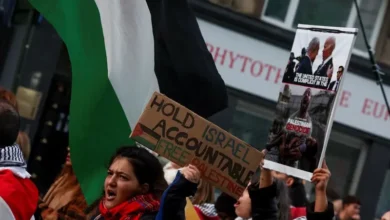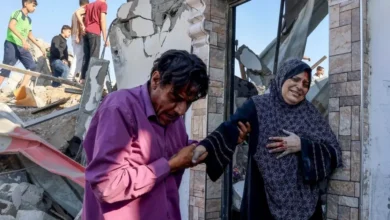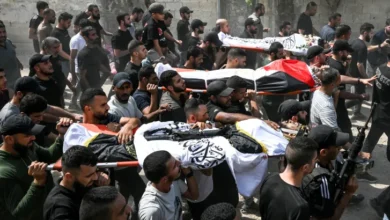Scarred by war, Myanmar children ‘cannot have the life they used to have’
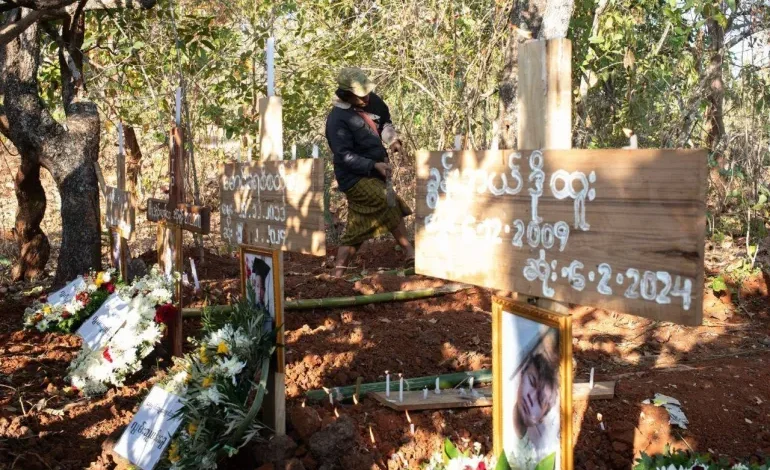
Ever since she witnessed a Myanmar military air strike on her school in February, kindergarten teacher Mi Hser has been haunted by the memory.
The day started like any other at the school in Daw Si Ei village in the southeastern Karenni State’s Demoso township. Children tossed around a football, while others played and shared snacks until the morning bell. Gathered outside for their weekly assembly, the 170 students listened as their teachers spoke. There was a buzzing overhead – a military drone – but neither Mi Hser nor anyone else took much notice.
The village had been living with war ever since the February 2021 military coup led to widespread nonviolent protests and then an armed uprising. Like other parts of the country, Karenni State – also known as Kayah State – has endured relentless clashes between the military and resistance forces, as well as brutal military attacks on civilians.
Still, Mi Hser’s village was about 27km (17 miles) from the nearest active conflict zone, and she believed that she and her students would be safe. But later that morning, as she stepped outside with her 11-month-old son during a break between classes, a fighter jet roared overhead. A fellow teacher pulled her back inside moments before a deafening explosion shook the building. Mi Hser saw rubble falling around her, and then everything went blank.
When she regained her bearings, a student was lying in a bunker, their head bleeding, and a teacher was holding another student who was barely conscious. In total, four boys were dead, the youngest just 12, while 40 more students were injured. Although Mi Hser had just seconds to react, she blames herself for not doing enough.
Since the attack, she has been incapacitated by fear, which keeps her from returning to the school to pick up her belongings from her classroom, and she has been struggling to sleep. “My eyes are wide open and my ears are listening for jet fighters or drones,” she said. “Even the sound of a cat jumping on the metal roof frightens me.”
Prolonged insecurity
In the three years since Myanmar erupted into heavy fighting between the military and anti-coup forces, the military has also retaliated against civilians with air strikes, shelling, other types of killings and arson – actions that United Nations-appointed human rights investigators have said amount to war crimes.
The crisis in Karenni and across Myanmar has only intensified since anti-coup fighters launched a renewed offensive against the military late last year. Earlier this month, the UN said the number of people forcibly displaced across Myanmar had surpassed 3 million, of whom nearly one-third were located in Myanmar’s southeast, including Karenni State.
The situation in Myanmar had “morphed into a never-ending nightmare” which is inflicting “unbearable levels of suffering and cruelty” on people in the country, the UN’s human rights office said in March. It found that the military was responsible for the deaths of at least 4,600 civilians since the coup, including 659 women and 490 children.
The attack on the school in Daw Si Ei village was not an isolated incident. The same day, the military also bombed a school in nearby Loi Nan Hpa village, killing the owner of a rice mill next door.
Both of the schools had operated under the civilian government the military generals removed from power, but had shut down after the coup due to a Civil Disobedience Movement, which included widespread student and teacher strikes. Like thousands of other schools across the country, the institutions later reopened under the leadership of community volunteers including government teachers who had joined the strikes.
The military has targeted such schools as well as other public services operating outside of its control. In September 2022, it bombed a school in the Sagaing region, killing 11 children. A month later, soldiers beheaded a volunteer teacher in the Magway region and impaled his head on the school gates.
Living under prolonged armed conflict and physical insecurity can wreak havoc on the mental health of individuals, families and communities, according to Nouf Bazaz, a clinical professor at Loyola University Maryland who focuses on trauma, grief and loss among survivors of armed conflict.
“The more prolonged the conflict, the more that social relations and institutions that we depend on for healing and connection erode,” she said. “Especially for children, trauma experienced during key developmental phases can alter the very structures of our neurological systems that are quite literally how we connect to the world.”
While targeted mental health and psychosocial support can help mitigate the impact of the kind of horrific events now taking place in Myanmar, such services are extremely limited in Karenni State, says Monica, a clinical psychiatrist who serves as a team leader for a remote mental health support programme under the National Unity Government (NUG), an administration established by the elected lawmakers the generals removed in the coup.
Although her organisation is doing what it can to train local doctors, nurses and volunteer workers, Monica adds that the coup exacerbated what was already a significant gap between mental health needs and services in Myanmar, leaving even remote mental health service provision difficult to provide in conflict-riven areas like Karenni State.
“It’s very hard for grassroots people in Karenni to access telehealth services due to the internet shutdowns by the Myanmar military,” she said.
‘Still alive in my mind’
In Daw Si Ei village, Mi Hser is not the only one suffering. Weeks later, her seven-year-old daughter was still walking in her sleep, and Mi Hser had to hold her son, now just more than a year old, through the night to soothe his screaming.
Children in the village are now startled by the noise of a car engine and few have gone back to school. Mi Hser worried that it may be impossible for the village to recover. “All the happiness has disappeared and children don’t smile the way they used to… They’re not as active,” she said. “The children cannot have the life they used to have.”
It is a feeling shared by Mi Htoo Htoo, whose son was killed in the attack, just two weeks before his 14th birthday. Weeks later, Mi Htoo Htoo, who is also using a pseudonym, still found herself calling out for him unconsciously. “He’s still alive in my mind,” she told Al Jazeera through tears.
Although the last time she saw her son, he was in a casket with an injury to his head, Mi Htoo Htoo tries to remember him in his Sunday church clothes, or talking about the aeroplane he planned to design, which ran on water rather than jet fuel.
The attack that killed her son also haunts Mi Htoo Htoo every hour of the day, and has left her in a perpetual state of anxiety. “Whenever I hear a fighter jet, my body trembles with fear and I feel like I’m completely drained,” she said.
She added that her surviving three children were also scared to leave the house, even for the music class at their church that they used to enjoy, and her 11-year-old was struggling to fall asleep.
‘Terrified’
Monica, the clinical psychiatrist serving under the NUG, expressed concerns about the wider impact of the conflict on Myanmar’s young generation, who are likely to carry the trauma with them into adulthood. “Their mental health has a huge impact on our society,” she said.
About 50km (31 miles) east of Daw Si Ei village, in the town of Shadaw, residents are also traumatised. The area has seen intense fighting between the military and Karenni resistance forces since November 2023, leaving the military increasingly on the defensive. Then, just the day before the attacks in Daw Si Ei and Loi Nan Hpa villages, a military helicopter touched down in Shadaw, dropping off about 60 soldiers, according to witnesses and media reports.
Naw Kaw Lay, 45, was on her rice paddy farm with her husband and two children at the time, and saw the helicopter from about 200 metres (219 yards) away. “I thought I was about to die and was absolutely terrified,” said Naw Kaw Lay, who hid with her family at the base of a rocky slope for the next five hours, and who has also been given a pseudonym.
They returned home that evening to find that soldiers had ransacked their house and looted their valuables. But the worst news came the next day, when they learned that resistance forces had found the bodies of three women from the village, one of whom was pregnant and two of whom had disabilities, along with the bodies of three children, aged three, five and seven. According to family members of the victims, all of them had been hiding in nearby paddy fields when they were abducted.

